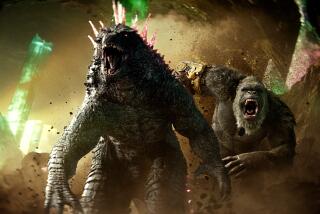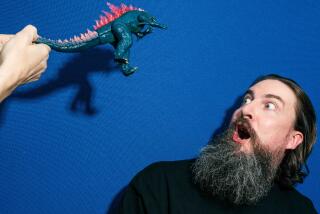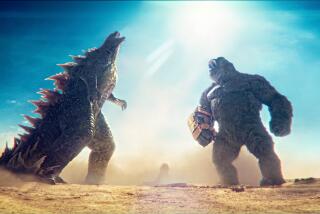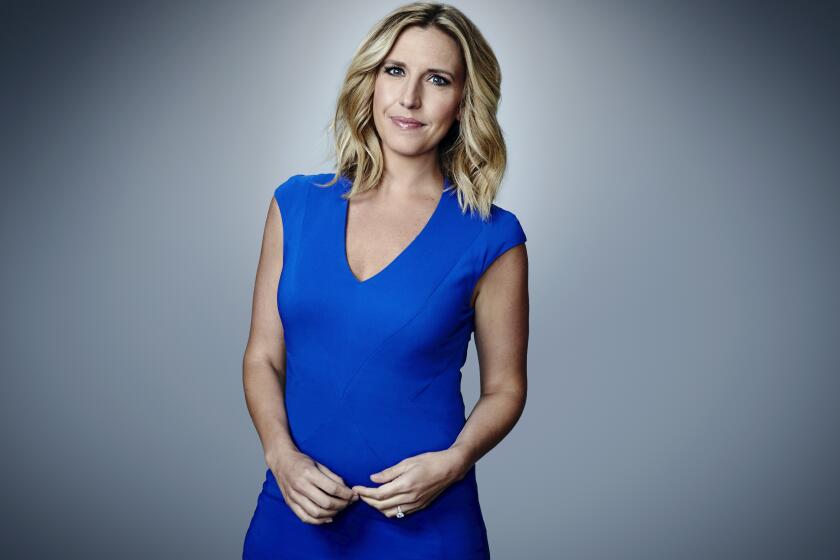Q&A: Takashi Murakami talks monsters, movies and Fukushima
A nuclear disaster, evil scientists and a malevolent monster with psychedelic eyeballs that wreaks havoc on a bucolic town. It isn’t “Godzilla.” It’s “Jellyfish Eyes,” the latest creation from artist Takashi Murakami, Japan’s industrious answer to Andy Warhol.
The movie is a 100-minute live-action kids’ flick that sits squarely in the Kaiju (Japanese monster movie) tradition. It tells the story of Masashi, a young boy who encounters a creature known as a F.R.I.E.N.D.: a floating avatar-sprite who likes to snack on processed cheese. There is also a crew of cape-wearing baddies that resemble a Japanese boy band, an end-of-the world cult, a bevy of pugilistic F.R.I.E.N.D.s, and a 130-foot monster named Oval who is made up of a whole lot of bad attitude.
A kids’ movie might seem like a bit of a departure for Murakami, an artist who has made a career out of creating sculptures of masturbating manga characters and giant metallic phalluses. But this isn’t his first kids’ project. At the 2007 Murakami retrospective at Los Angeles’ Museum of Contemporary Art, an entire room inside the Geffen Contemporary was devoted to his “kaikai & kiki” films. And as the artist has made clear, “Jellyfish Eyes” isn’t simply a kids’ movie. It’s about confronting the 2011 Fukushima disaster.
This isn’t the first time a filmmaker has taken on the subject. In 2012, prolific Japanese director Sion Sono addressed Fukushima in “The Land of Hope.” This year, director Nao Kubota, added the drama “Homeland” to the list. And, at the risk of sounding trite, there is also the new “Godzilla,” which deals with a nuclear disaster and a tsunami (amid a bajillion hours of backstory).
Fukushima is not exactly ace-in-the-hole movie material, especially in Japan, where it remains a sensitive topic. “Jellyfish Eyes” did poorly when it was released there last year. But, it’s not as if Sono’s “Land of Hope” was widely hailed either. That movie was criticized for coming too soon on the heels of the disaster.
Whether Murakami’s picture might play well in the U.S. remains to be seen. It takes a while for the $7-million movie to get going, but things pick up in the second half, when the various avatar-sprites get in some righteous butt-kicking. Plus, the climactic showdown with the giant monster actually has more tension than anything in “Godzilla” (which, by comparison, cost $160 million to make).
Currently, “Jellyfish Eyes” is screening as part of a limited multi-city U.S. tour. He hit Los Angeles late last week, holding a packed screening at the Theatre at the Ace Hotel (organized by his long-time L.A. gallery, Blum & Poe). The next showing is Thursday, June 5, at the Asian Art Museum in San Francisco. And Murakami is currently in negotiations for a wider release.
When he was in Los Angeles last week, he sat down for a freewheeling conversation about art and film with essayist Pico Iyer at an event organized The Broad museum. There, he discussed what it is like to direct both an art studio and a feature film: “My job is to say no,” he explained. A role, he joked, that generally results in someone saying, “... you, Takashi.” (See the entire conversation here.)
While running around L.A., Murakami also took a few minutes to chat with me (via translator) about “Jellyfish Eyes,” his favorite American movies, and why he took home a graffiti-covered billboard at the end of his 2007-2008 solo exhibition at MOCA.
What inspired the decision to make this movie?
I was thinking about my childhood in Japan when Kaiju monster movies were at their peak. There was a real fear of the effects of nuclear experiments that coincided with the Kaiju monster movies. Like in “Godzilla,” where there are hydrogen-bomb and atomic-bomb experiments going on across the Pacific Ocean. [I started to] think about the earthquake and tsunami disaster [of 2011] together with Fukushima. [That] triggered this film.
Your art is filled with explosive clouds and post-nuclear monsters, and the film directly references the tsunami. Why are disasters so significant to you?
In my art career I have curated several show exhibitions and one of them was “Little Boy,” which was held in New York at the Japan Society several years ago. The title of that show comes from the name of the atomic bomb that was dropped in Japan. Post World War II Japan has never created its own identity. It has never matured. As a Japanese and an artist I always wonder how I should approach contemporary art, which I’ve seen imported from the West. So in my career, I’ve researched and underscored this theme. And that’s something that is present in both my art and my film.
What inspired the designs of the individual F.R.I.E.N.D.s characters?
I wanted children to be the audience of the film. When I designed the characters, I thought of animals children might like. So there are crabs and frogs and an octopus – and robots as well.
“Jellyfish Eyes” contains a junk-food-eating alien avatar that seems to be an homage to “E.T.: The Extra-Terrestrial.” What other American movies have been influential to your work?
Yes, I have received influence from other movies, especially movies like “Gremlins,” by Joe Dante. And also by Dante, “Explorers.” It’s the type of movie where the main characters are children and they encounter unknown creatures and it’s a coming of age through that kind of encounter. I feel like I don’t see so many of that type of movie these days. But these movies with monsters and children being the main characters, they tend to be evident when there are worries and anxieties in the society. Right now, it’s the right moment in Japanese society for these movies to appear.
I hear there is a “Jellyfish Eyes 2” in the works. What do viewers have in store?
We have already done the live action scenes. We are getting into post production, with the music and computer graphics things – over 2,000 cuts. I will complete by the end of next year, but to plan distribution takes more [time]. I think it will help explain what I was trying to say in part one much better.
In Hollywood, we have a tradition of reducing complex and nuanced movie narratives into a single, one-line pitch, like, “It’s ‘Batman’ meets ‘Terms of Endearment.’” How would you describe your film?
[Laughs.] I would just say it’s a brand new Japanese Kaiju movie.
Which brings me to another L.A.-related issue. In 2008, when you were in Southern California for the end of your exhibition at MOCA, a couple of graffiti artists – Augor and Revok – tagged up one of the billboards for the show. You took the billboard to Japan. What are your plans for it?
I actually collected all the billboards that were up whether they had graffiti or not. This is because when I went to the Warhol Museum in Pittsburgh, what impressed me the most was the room called “Time Capsule.” They gathered all of Warhol’s everyday objects and trash and everything that he had in his life in one room. It took people years to go through everything and analyze all of those objects. The most important thing about Warhol is not just the art work itself, but the process – how he approached the work, how he lived, how he became Warhol. As an artist, I should collect everything from my life as I can. If I don’t collect these, then they might be discarded. Or someone will take it and put it on auction. [One day,] I’m hoping to do an exhibition like “Time Capsule.”
More to Read
The biggest entertainment stories
Get our big stories about Hollywood, film, television, music, arts, culture and more right in your inbox as soon as they publish.
You may occasionally receive promotional content from the Los Angeles Times.







